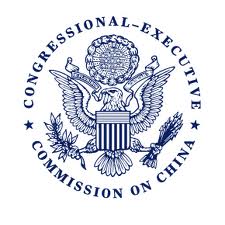The bipartisan Congressional-Executive Commission on China has released its annual report on human rights and rule of law in China. Charlie Campbell at TIME reports that the commission particularly focused on five areas: rule of law, civil society, labor rights, media, and nationalism:
The almost 80,000-word bipartisan U.S. Congressional-Executive Commission on China (CECC) 2016 report, released Thursday morning, raises long-festering issues such as repression of ethnic minorities in Tibet and Xinjiang, as well as the erosion of autonomy in the Special Administrative Region of Hong Kong.
However, the CECC notes a broader corrosion of freedoms, encompassing a social and political reinforcement of the supremacy of the CCP under Xi’s leadership, with deleterious consequences for civil society, media freedom, labor rights and judicial due process.
“Xi has overseen a deterioration in human-rights and rule of law conditions in China marked by greater consolidation of his own power — leading some analysts to draw comparisons to Mao Zedong — through forced ideological conformity and the systematic persecution of human rights lawyers and defenders,” says the CECC report. [Source]
At The Diplomat, Shannon Tiezzi compares the CECC report to an official Chinese government paper outlining its plan for human rights over the next five years:
Interestingly, the CECC’s report was released only a few days after China unveiled its own human rights agenda: the National Human Rights Action Plan of China (2016-2020). The full text, in English translation, is available from Xinhua. It’s the third NHRAP in China since 2009; the previous two covered the periods from 2009-2010 and 2012-2015.
The fortuitous timing of the two reports allows for a clear glimpse of how the CPC’s definition of “human rights” differs from the prevailing Western view. In China, the NHRAP makes clear, human rights must always take a backseat to Party rule, justified through appeals to “stability” and pre-existing laws. In China, granting rights “in accordance with the law” is generally code for “as long as it does not cross CPC red lines.”
Many of the points criticized in the CECC report are also present, albeit in vague generalities, in the NHRAP. However, the very first objective of the NHRAP showcases perhaps the sharpest difference between the two. The Chinese conception of human rights starts (and, all too often, ends) with the idea of economic and material prosperity. Thus, the number one promise of the NHRAP is to “improve the people’s standard of living and quality of life” – including steps that would never appear in a Western human rights framework, such as creating stronger intellectual property rights, improving China’s transportation networks, and “establishing a dissemination system of China’s fine cultural traditions.”
On other areas, the CECC and NHRAP are discussing the same subjects, but effectively speaking different languages. It’s often been pointed out, for example, that the Chinese emphasis on “rule of law” or fazhi is better translated as “rule by law,” as the CPC has repeatedly made clear that it will remain above the law, and not the other way around. [Source]
Read more about the NHRAP, via CDT. See also the full text of the CECC report.








